Hisense RS723N4WC1 Review
Hisense RS723N4WC1 Review
A large, stylish and good-value fridge freezer
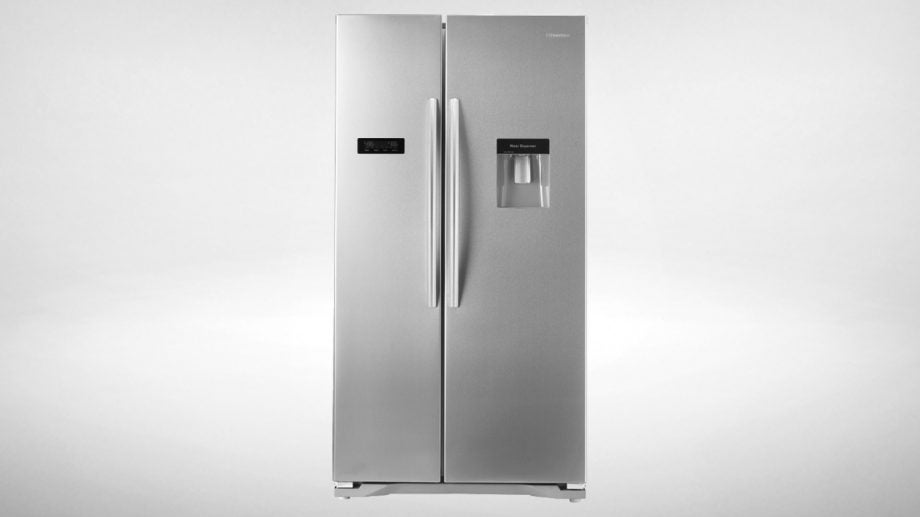
Verdict
Pros
- Great look and finish
- Outstanding value
- Huge capacity
- A+ low running costs
- Consistent temperatures
- Multi-airflow cooling
Cons
- LED lights blocked by produce
- Frost potential on top shelf
- Not the quietest fridge freezer
- Only 8-hour power fail food safe
Key Specifications
- Review Price: £599.00
- 364-litre fridge capacity
- 192-litre freezer capacity
- Water dispenser
- LED lighting
- Stainless steel-effect front
What is the Hisense RS723N4WC1?
Full-size US-style fridge freezers don’t come to our test bench offering much better value than the Hisense RS723N4WC1. At a whopping 91cm wide and sporting more than 550 litres of total cooling capacity, it’s big on size and just as big on features.
Side-by-side fridge freezers at this price don’t normally offer a in-door chilled water dispenser, frost-free multi-airflow cooling and touch controls with LED display. Add in the great-looking stainless steel-effect finish (gloss black if you prefer), a well-appointed interior with LED lighting and an upmarket twist-and-store ice-cube maker, and the RS723N4WC1 is starting to look like a real bargain.
Hisense RS723N4WC1 – Design and Features
Stainless steel is nice, but stainless steel-effect finishes are often far more practical for resisting finger marks and being easy to clean. That is certainly true of the Hisense RS723N4WC1, which combines the look of real stainless steel with the practicality of a lacquered finish. The chunky handles have a great feel and are finished in a contrasting brushed effect, which did an equally good job of hiding greasy hand prints.
The sheer acreage of the full-size doors is broken up with a stylish blue LED display on the left, chilled water dispenser on the right, a full-width plinth at the bottom, and a subtle Hisense badge at the top. It’s cool, stylish and really rather fetching.
The water dispenser is a good size to accommodate larger glasses and features a removable drip tray. This is fed by a 4-litre water container inside the fridge, so you won’t have to get a plumber in. The doors, trim and handles all line up perfectly – misalignment is common on budget side-by-side appliances.
Related: Best Fridge Freezers
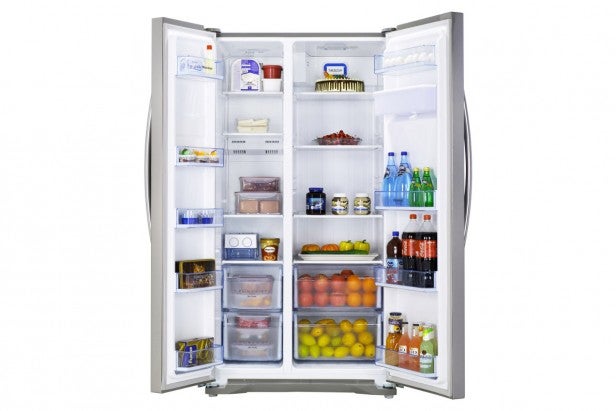
Open the wardrobe-like doors and you’re greeted with wardrobe-like space – some 556 litres of usable capacity, split 65/35 in favour of the fridge. Both compartments are lit from the top by bright white LED lights, but they’re a little too far set back, so are easily blocked by a top shelf full of produce.
Both sides of the unit offer four glass shelves and two pull-out drawers. The drawers run on simple plastic sliders, rather than rollers, so will require a bit of force to move when fully loaded. Storage in the lowest drawer sides is hampered by their truncated size, as a result of the compressor and other workings at the rear of the appliance.
The water container for the front dispenser is easy to remove and fill, although how long 4 litres will last with a big family in the height of summer is questionable. We decided that in this situation we’d use the dispenser’s child-lock feature and fill the container with Pimms. In the freezer, there’s a removable twist-and-store ice-cube maker that worked well. Pimms and ice – perfect.
While you don’t get ultra-fancy features such as variable temperature cooling zones, the RS723N3WC1 does offer multi-airflow cooling for both the fridge and the freezer.
Best American-style fridge freezers
This system circulates colder air from the compressor around the compartment with a fan to ensure a more even cooling temperature throughout the entire compartment and total no-frost operation. It also works with this model’s Super Freeze and Super Cool functions, which chill down either compartment rapidly when you’ve filled them with fresh produce.
These features, along with degree-by-degree temperature control are accessed by the touch control panel on the front of the fridge. It took us a while to figure out the five-second delay and the way the features operate (no, we don’t read the manual, either…) but the controls soon became second nature.
To save a few pennies while you’re away – and therefore won’t be opening the fridge freezer doors – there’s a holiday mode that further increases energy efficiency.
Hisense RS723N4WC1 – Capacity and Layout
The RS723N4WC1 is cavernous and offers pretty much the maximum chilling and freezing capacity possible from a 91cm-wide appliance. There’s little in the way of ancillary furniture to reduce space, save the ice-cube maker in the freezer and water container in the fridge, making this a fridge freezer for the largest of families – or super-keen chefs.
The smaller freezer offers 192 litres (net) of freezer space across four shelves, two drawers and five decent-sized door pockets. However, the ice-cube maker is an odd size relative to the shelves and takes up a good chunk of space. While there is space above it for storing items on top, they’ll have to be removed each time it needs to be refilled.
Also, although the twist feature worked well, the ice-cube maker could have done with being integrated into a door pocket to save real-estate in the freezer. Of course, if you’re short of space it can be removed completely, unlike bulky built-in ice dispensers.
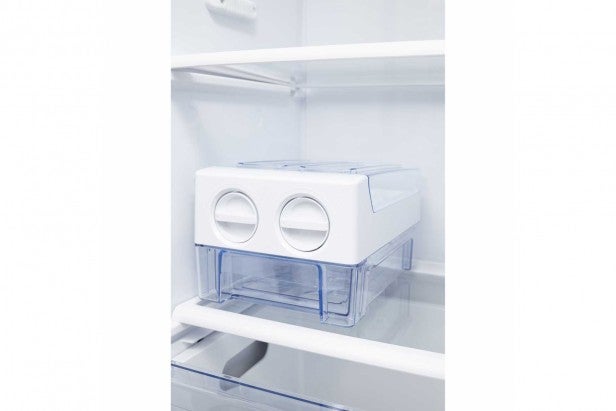
The central two shelves in the freezer offer limited height adjustment, but we found there was a limit to how much you could get on each without reaching a natural angle of repose where things start falling out anyway. Each area is huge, but for the sake of easily finding that long lost pack of frozen peas, it might have been better to include another drawer.
The same is true of the freezer door pocket. While five seemed ample, the air-space between door pockets is redundant as the main shelves and drawers are set back to accommodate them. Including a further two door pockets, or perhaps deeper main drawers and foregoing the lower door pockets, would have been a more efficient use of the space.
No such issue in the whopping 364-litre fridge. With only the water container taking up any space, and that being well out of the way, the fridge is fully usable.
The four-shelf and two-drawer combo is ideal here, since the taller shelves allow you to stack containers – and, while there’s a limit to the adjustment of the two mid-shelves, we found the standard lower positions ideal. Only the very top shelf loses any space to features; it houses the multi-airflow cooling and total no-frost system.
Door pockets in the fridge are ideally spaced for bottles and jars – which is just as well, since there’s no way to alter their position. Each pocket is suitably deep front to back and just about tall enough to stop items leaping out as a result of vigorous door opening.
Hisense RS723N4WC1 – How noisy is it?
By current standards, the RS723N4WC1 isn’t the quietest of fridge-freezers. It’s up against some tough competition, even if the majority of models we’ve tested are far more expensive. We measured this model at 43dB while the compressor was running, identical to that stated on the EU energy label. That isn’t super-silent, but it’s far from intrusive and likely to sound much quieter than any older fridge freezer it’s going to replace.
The airflow cooling was certainly responsible for a little of that noise; you could identify the fan along with the compressor sound. However, the RS723N4WC1 was blissfully free of pops, clicks or gurgles. In our tests, the compressor would run for around 40 minutes before shutting down for about an hour – typical of this size of machine. There was a slight increase in noise in the first few minutes of the compressor running, kicking in at 47dB, but this soon levelled out at a subtle 43dB hum.
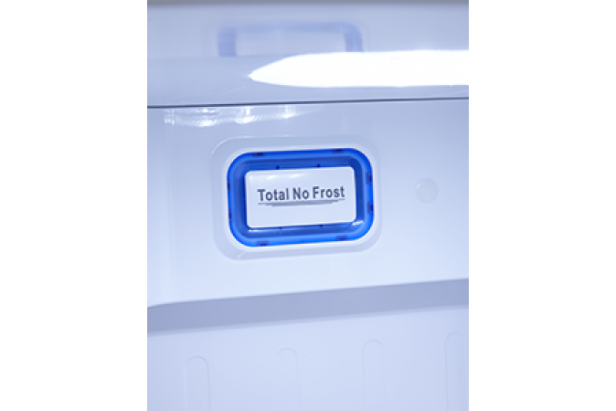
Hisense RS723N4WC1 – Performance
With its A+ energy rating and multi-airflow cooling, the RS723N4WC1 promises to be both efficient to run and offer even cooling. With the widespread availability of fresh and organic produce, consistent temperatures in the fridge have become ever more important for keeping items fresh and retaining maximum nutrients and vitamins.
We loaded up the Hisense with 0.5kg of produce per 10 litres of fridge space and 1kg of frozen food per 10 litres of freezer space, including 2 litres of room-temperature water to simulate fresh-to-frozen cooling. We actually had to go shopping to get enough produce to fill the capacious fridge compartment, which confirmed our thoughts that the layout of the refrigerator is both practical and useful.
The fridge freezer is kept in an environmental chamber at around 18-19oC to simulate a UK kitchen, and we opened the doors six to eight times per day to simulate normal use.
We certainly weren’t expecting the performance of top-specification side-by-side models costing three times the price, yet the RS723N4WC1 turned in a very respectable set of technical test results for the price.
The large fridge compartment benefited from the multi-airflow cooling: average temperature range from top to bottom was within a degree or two of the 4oC set on the thermostat. With the coolest area being the top shelf at 4.0oC and the warmest the top drawer at 5.7oC, this is just a little on the warm side. Setting the thermostat to 3oC would see pretty much the perfect spread of temperature, from 3 to 5oC throughout the compartment.
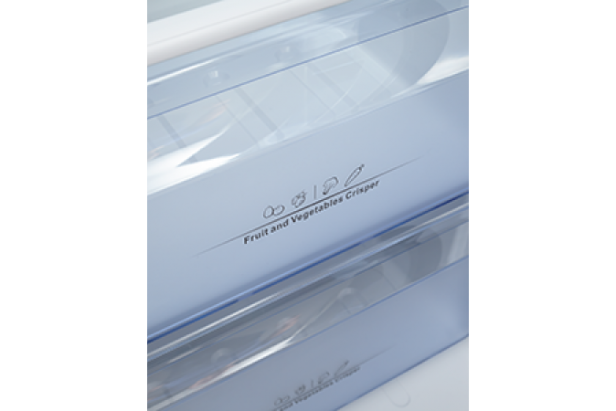
Temperature stability in the fridge – how far the temperature wavers from the average through the compressor cycle – was also very good on all but the very top shelf. Here the outlet for the multi-airflow cooling over-chilled the area, so the air would briefly drop well below freezing. This shelf would be best for produce in containers and jars, which won’t be affected by the brief chilly blasts.
The average temperature in the freezer was first-class, with the whole compartment being within just half a degree of the thermostat selected -18oC. Our fresh-to-frozen test showed a very lengthy 23 hours for the water to freeze to the core. The Hisense also offers a Super Freeze function to speed up the process, which is worth using when you’re freezing down fresh produce.
Temperature stability in the freezer wasn’t quite so impressive, but nevertheless decent for a unit of this size. The lower shelf and bottom drawer would bounce around approximately +/- 3oC as the compressor switched on and off, while the top shelf showed a slightly more sizeable swing of +/- 5oC. Over the short compressor cycle of about an hour and half, these fluctuations in air temperature won’t make a great deal of difference to the life of frozen food.
The simulated power cut of three hours proved a bit of a sticking point for one area of the RS723N4WC1 in particular. While the freezer temperatures in the lower shelves and drawers showed a fairly typical temperature rise of between 6.4 and 8.7oC during the power cut, the top shelf rose a whopping 15oC. Our food sample on the mid shelf remained solidly frozen, rising just over 6oC at its core.
However, since our fail tests are based on a worst-case scenario – food on the top shelf and the power outage happening at the warmest part of the compressor cycle – this Hisense scored fairly badly in the power-fail test with a food safe estimate of no more than eight hours.
On the plus side, when the power returned the RS723N4WC1 recovered quickly, getting air temperature back down to -18oC in just 32 minutes.
Hisense RS723N4WC1 – Running costs
The Hisense’s A+ rating is good for this size of appliance, and excellent when you consider its relatively affordable asking price. You could spend far more for models with more +’s after the A, but would be unlikely to ever see a return on investment in terms of energy cost saving alone.
Running in our controlled 18oC environment, with each door opened six times per day for approximately 20 seconds, the RS723N4WC1 used just 1.07kWh per day – or about 16p.
Over the course of a year that would be around 390kWh, approximately £58.50 assuming you’re paying an average tariff of 15p/kWh. Like all refrigeration appliances, if situated in a very hot kitchen environment, with a larger family opening the doors more frequently, these costs will increase significantly.
Nonetheless, given the sheer cooling capacity and budget price ticket, the Hisense RS723N4WC1 offers respectably low running costs.
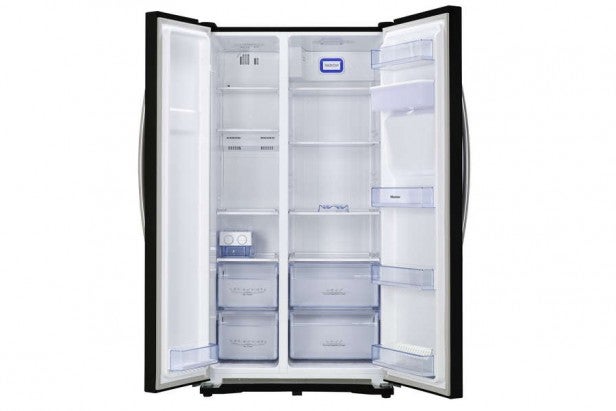
Should I buy the Hisense RS723N4WC1?
While the RS723N4WC1 isn’t without its niggles – the slightly awkward freezer lay-out, chilly top shelf in the fridge and a poor power-fail test results for example – none of these proves a deal breaker. This classy US-style side-by-side offers outstanding capacity, consistent temperature performance, economical running and, for its bargain price, a really up-market fit and finish too.
Verdict
Stylish, capacious and offering decent all-round performance, the RS723N4WC1 is a great budget choice for large families.


